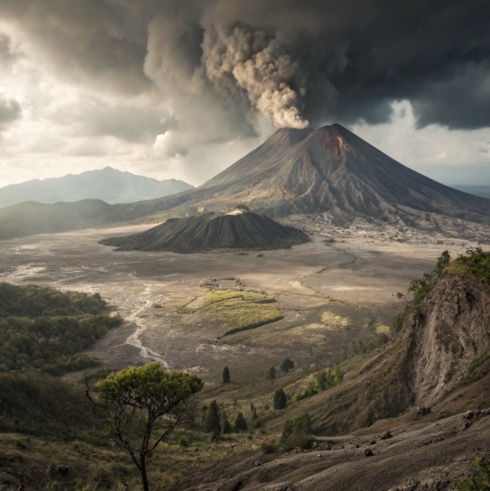One Volcanic Blast, Planet-Wide Results

Not all disasters leave immediate scars. Some reshape the world slowly, through seasons and cycles. In 1815, a single eruption on Indonesia’s Sumbawa Island turned into one of the most influential events of the 19th century.
Mount Tambora didn’t just flatten its own peak — it unsettled climate systems, ruined crops on multiple continents, and even played a role in one of history’s most famous battles.
Pressure Builds: The Earth’s Warnings Before Tambora
A Slow Buildup of Ash and Gas
Years before Tambora erupted, the skies were already changing. Between 1808 and 1814, several volcanoes released ash and gases into the upper atmosphere:
- A mysterious eruption in the Pacific in 1808
- La Soufrière (Saint Vincent) and Awu (Indonesia) in 1812
- Suwanosejima (Japan) in 1813
- Mayon (Philippines) in 1814
Each event added to a growing shield in the atmosphere, dimming sunlight and gradually lowering temperatures. The stage was set for a major shift.
The Main Blast: April 1815
A Mountain Breaks Apart
On April 5, Tambora began releasing ash. Five days later, on April 10, it erupted with enormous force. The sound carried over 1,600 miles, and the blast removed over 4,000 feet from the mountain’s height. What remained was a crater stretching 3.7 miles wide and nearly 2,000 feet deep.
Around 10 cubic miles of debris were launched into the air — enough to blanket parts of the globe and block sunlight in regions far beyond Southeast Asia.
The Sky Turns Dark — and Red
Ash Clouds Circle the Globe
Within hours, Tambora’s impact was felt well beyond Indonesia. Ships in the Indian Ocean reported sailing through floating fields of pumice — some 5 kilometers wide. More than 370 miles away, buildings collapsed under the weight of ash.
The fallout dimmed skies across the region, plunging nearby areas into darkness for nearly 48 hours. The ash reached the Bay of Bengal, South China Sea, and continued to spread through upper air currents.
In Europe, people noticed a change too. Skies turned red during sunsets, a direct result of ash particles scattering light in the upper layers of the atmosphere. The effect was visually striking — but also a warning of climate trouble ahead.
Global Cooling Begins
A Drop in Temperature, a Rise in Crisis
By the end of 1815, global temperatures had fallen by as much as 1.2°C, based on findings from a 1992 Natural Hazards study. Though the shift may sound minor, its consequences were anything but.
The cooling pattern impacted rainfall, shortened growing seasons, and froze rivers during warm months.
The Mount Tambora Eruption at a Glance
| Event Detail | Measurement / Description |
|---|---|
| Eruption Date | April 10, 1815 |
| Location | Sumbawa Island, Indonesia |
| Volume of Ejected Material | ~10 cubic miles (~40 km³) |
| Sound Travel Distance | Over 1,600 miles |
| Mountain Height Loss | More than 4,000 feet |
| Caldera Width | 3.7 miles (approx. 6 km) |
| Darkness Duration | Up to 2 days |
| Temperature Drop | Around 1.2°C |
| Lasting Result | Year Without a Summer (1816) |
From Asia to Europe: Crops Fail, Diseases Spread
The Chain Reaction No One Expected
In Europe, cold temperatures and out-of-season snowfall damaged agriculture. In Hungary and Italy, snow fell in July. Farmers lost their harvests, and panic followed as food became scarce.
In South Asia, failed monsoons were replaced by delayed downpours, leading to floods across the Ganges basin. These conditions helped accelerate disease outbreaks — and by 1817, the world saw the beginning of the first cholera pandemic, originating in Bengal and spreading along trade routes to the Middle East, Africa, and beyond.
Meanwhile, in Belgium, the Battle of Waterloo may have taken an unexpected turn thanks to Tambora. Weather conditions, worsened by ash-influenced atmospheric changes, left the battlefield wet and muddy — slowing Napoleon’s advance and affecting the outcome.




